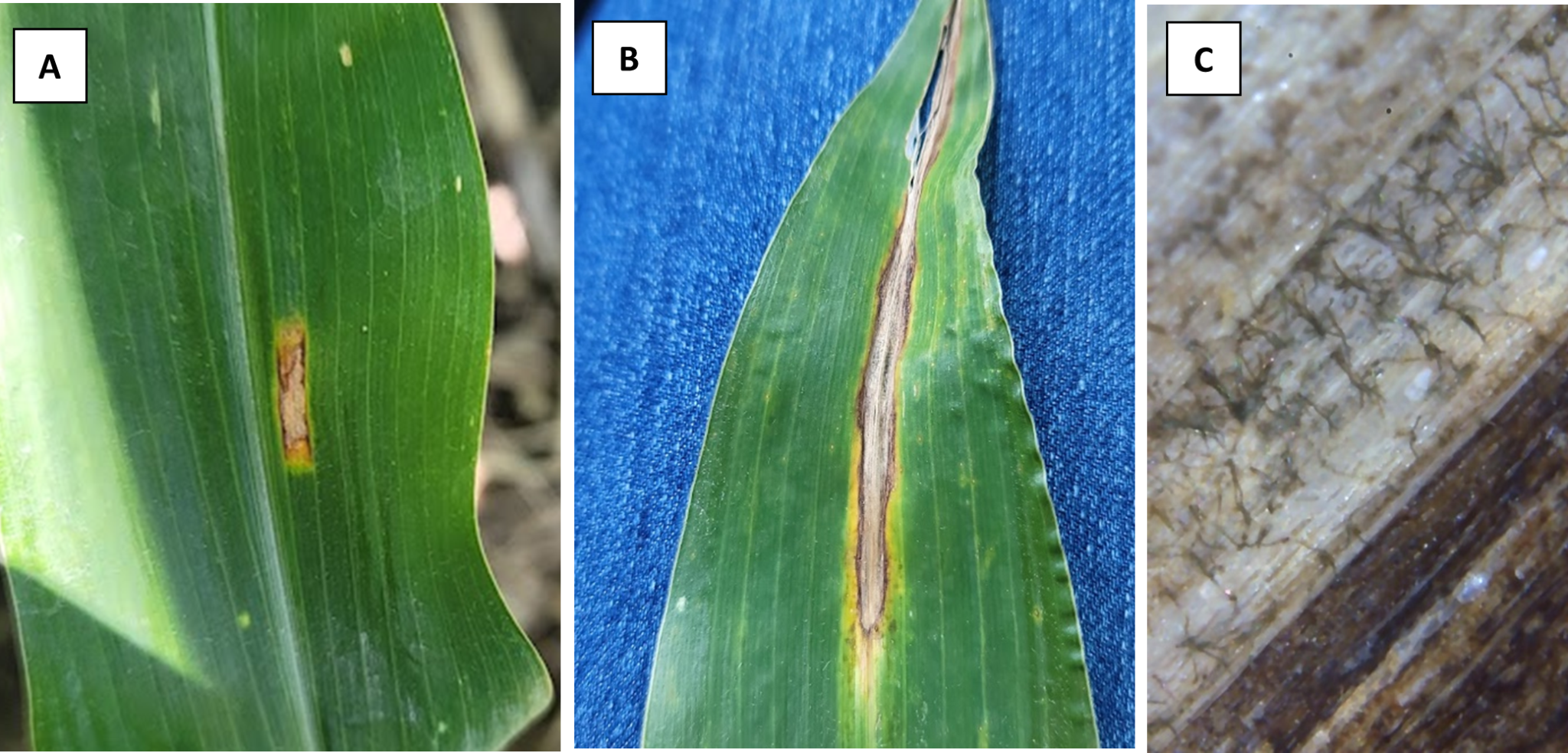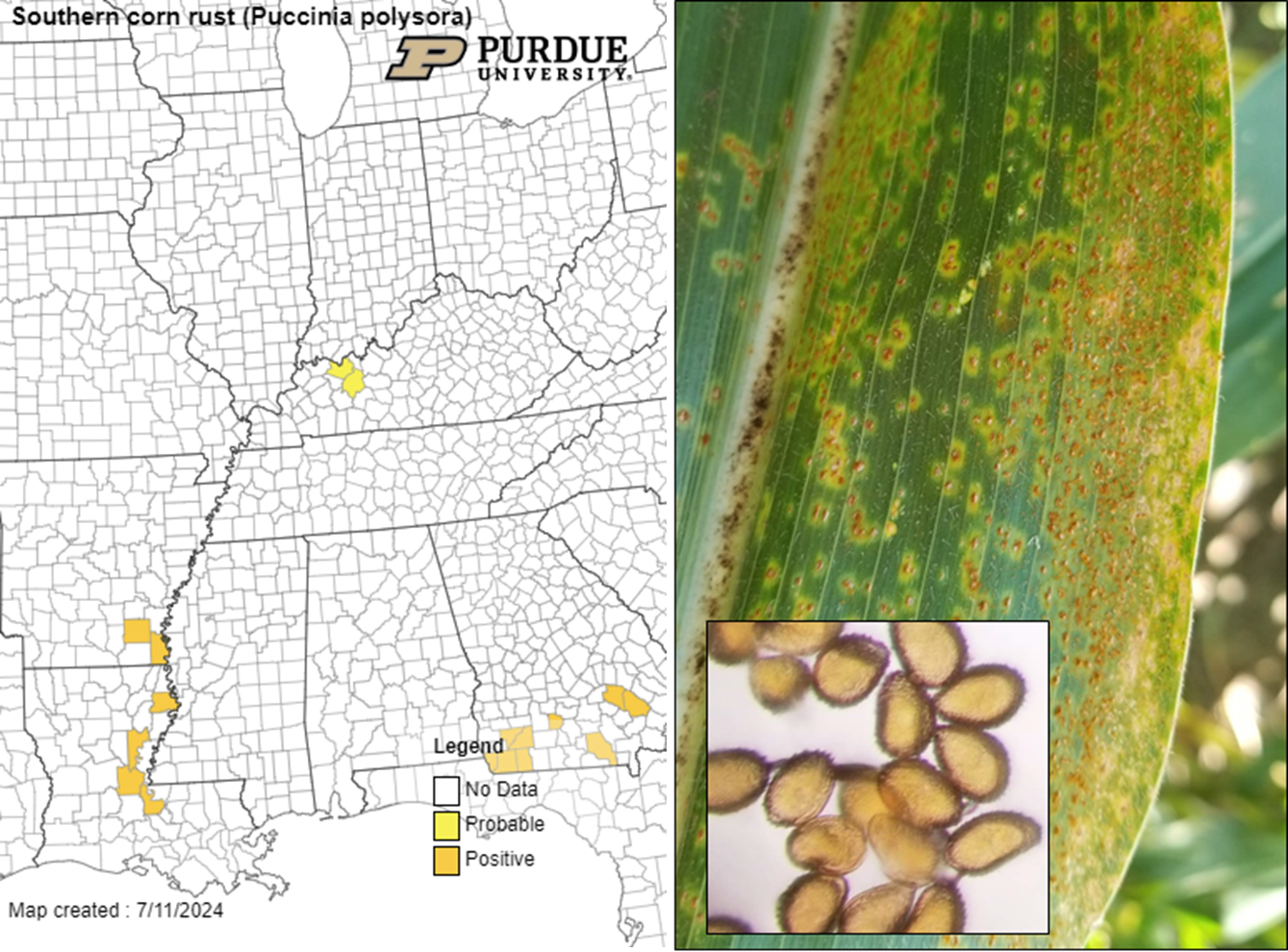It is important to continue to scout for diseases in both corn and soybeans. Recent rains following Beryl have created favorable environmental conditions for the development of foliar diseases in both crops. In my scouting rounds and samples submitted to the Purdue Plant Pest Diagnostic Lab (PPDL) this week we continue to find tar spot, gray leaf spot, northern corn leaf blight, and common rust in corn (Figures 1 and 2). No major foliar diseases in soybean found just yet. We continue to add counties with active tar spot in Indiana. The most frequent question I have received is, “Should we make a fungicide application?” My response – What diseases are you finding in your field? What is your hybrid/variety susceptibility and field history? What growth stage? Are you irrigating?
A fungicide application can be effective at reducing disease and protecting yield, but there are a number of factors that need to consider:
- Field history/previous crop – what diseases have been an issue in previous years?
- Amount of disease present in the field – what diseases do you find? Where are they in the canopy? Is the disease active in your county or surrounding counties?
- Hybrid/variety susceptibility to diseases
- Current weather conditions (use apps such as Tarspotter, Sporecaster, Field Prophet)
- The value of the crop and cost of fungicide application.

Figure 1. Foliar diseases in corn A. gray leaf spot, B. northern corn leaf blight with C. conidia visible in lesion using my portable hand-held microscope. Both of these were found on lower leaves in corn that was beginning to tassel. (Photo Credit: Darcy Telenko)
Tar Spot: Tar spot continues to be on everyone’s mind. We continue to add new counties where active tar spot lesions have been found in Indiana (Figure 2). We have confirmed tar spot in 26 counties thus far this year. Tar spot had previously been found in 87 counties (gray color) in Indiana. Many of these tar spot detections have required intensive scouting, but as the disease progresses it will be easier to find as the number of spots increase and it moves up the canopy. We will continue to monitor and update as the season continues.
See recent updates on details for fungicide timing and applications for tar spot:
We continue to research best management practices for tar spot to minimize losses. The good news is that we found a number of fungicides are highly efficacious against tar spot when applied from tassel (VT) to milk (R3). I would recommend picking a product with multiple modes of action. The national Corn Disease Working Group has developed a very useful fungicide efficacy table for corn diseases (see link below). We will continue keeping a close eye on tar spot. Please contact me if you suspect a field has tar spot please or send a sample to the Purdue PPDL for confirmation.

Figure 2. Tar spot lesion on corn in lower canopy, I was finding these on leaves 6 to 8 in our research plots. High resolution of the stroma formed on the leaf. (Photo Credit: Darcy Telenko)
Southern Rust has not been officially confirmed in Indiana yet, but there are some suspect reports in Kentucky (Figure 3). I suspect southern rust may be found in southern Indiana where spores settled after moving on weather systems from the south. We need your help – if you are out scouting fields please let us know if you find any suspect samples and please send to the Purdue Plant Pest Diagnostic Lab. We need a physical sample in order to confirm southern rust. https://ag.purdue.edu/btny/ppdl/Pages/Submit-A-Sample.aspx.

Figure 3. Distribution of southern rust in U.S. on July 11, 2024, orange counties are positive and yellow counties are probable (https://corn.ipmpipe.org/southerncornrust/) and an example of southern rust pustules on a corn leaf and diagnostic spores. (Photo Credits: Darcy Telenko and John Bonkowski)
Southern rust pustules generally tend to occur on the upper surface of the leaf, and produce chlorotic symptoms on the underside of the leaf. These pustules rupture the leaf surface and are orange to tan in color. They are circular to oval in shape. We are also seeing some common rust as well and both diseases could be present on a leaf.
There are a few characteristics to use to try to distinguish southern rust from common rust. Common rust will form pustules on both sides of the leaf. In addition, common rust pustules tend to be spread out across the leaf, and less densely clustered. Common rust pustules have a brick red to brown coloration and may be more elongated than southern rust pustules.
Check out the southern rust publication for more images of southern rust and other diseases that might mimic it. This publication also has good information on determining when a fungicide application will be beneficial. The publication is at following link: https://cropprotectionnetwork.org/publications/an-overview-of-southern-rust
Each year the rust spores (urediniospores) travel on air currents from tropical regions to fields in Indiana. Short periods of leaf wetness are required for infection by both rust fungi. Morning dews in Indiana can provide the six hours of moisture required for infection and disease development. Generally, southern rust prefers warmer temperatures — with infection occurring between 77-82°F.
Both gray leaf spot and northern corn leaf blight disease can also be found in corn across the state. It is going to be extremely important to be out scouting, especially if you are trying to make a decision on a fungicide application.
Gray leaf spot is active in the lower at multiple sites across the state. The lesions are light tan in color and generally narrow and rectangular, and can be as long as 2 inches. As the lesions age they turn grey in color and are delimited by leaf veins (Fig. 1). This annual disease has become one of the most important foliar diseases in Indiana. Hybrid susceptibility and weather will have the greatest impact on the severity in a field. Fungicide options that are available for gray leaf spot would be a cost-effective application in fields that have a history of disease and planted to susceptible hybrids in no-till or reduced-till system.
As a reminder the field history, disease activity, hybrid susceptibility, weather conditions, the value of corn and soybean, and cost of fungicide application are factors that should be considered in making a decision to apply a foliar fungicide. Several fungicides are available to help manage these foliar diseases with a recommended application occurring at late vegetative stages through R1 in corn, R1-R3 in soybean for white mold, and R3 in soybean for frogeye leaf spot.
Resources:
- Fungicide efficacy table for corn diseases: https://cropprotectionnetwork.org/publications/fungicide-efficacy-for-control-of-corn-diseases
- Fungicide efficacy table for soybean foliar diseases: https://cropprotectionnetwork.org/publications/fungicide-efficacy-for-control-of-soybean-foliar-diseases
- Purdue Field Crop Pathology website for current updates https://indianafieldcroppathology.com/
As a reminder due to the need to monitor both southern rust and tar spot in Indiana, there will be no charge for southern rust and tar spot samples submitted to the PPDL for diagnostic confirmation. This service is made possible through research supported by the Indiana Corn Marketing Council. Please feel free to contact me (dtelenko@purdue.edu) or the PPDL (ppdl-samples@purdue.edu) with any major disease issues you may have this season.


